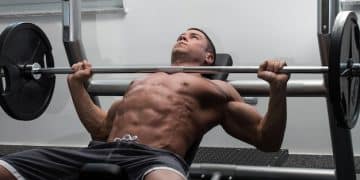Post-Workout Nutrition: Optimal Muscle Recovery & Growth 2025

Achieving optimal muscle recovery and growth in 2025 hinges on precisely timed and nutrient-dense post-workout nutrition, emphasizing a strategic blend of proteins and carbohydrates to replenish glycogen and repair muscle tissue efficiently.
In the relentless pursuit of peak physical performance and body composition, many dedicate countless hours to rigorous training. Yet, what often separates marginal gains from truly transformative results isn’t just the intensity indoors but the intelligent replenishment immediately after. As we navigate 2025, understanding Post-Workout Nutrition: The Optimal Plan for Muscle Recovery and Growth in 2025 becomes not just beneficial, but essential for maximizing your efforts.
Understanding the Post-Workout Window
The concept of a “post-workout window” has evolved significantly over the years. Initially, it was believed that there was a critical, short timeframe—often cited as 30-60 minutes—during which nutrient intake was absolutely crucial for maximizing muscle protein synthesis and glycogen replenishment. Failure to consume nutrients within this precise window was thought to severely hinder recovery and adaptation.
However, more recent and refined research provides a more nuanced perspective. While timely nutrition remains important, the “window” is now understood to be far more flexible, particularly for those who have consumed a pre-workout meal or have maintained consistent meal timing throughout the day. The primary goal is still to capitalize on the body’s heightened sensitivity to nutrients immediately following exercise, but the pressure of a hyper-narrow timeframe has largely dissipated.
The post-workout period is characterized by several physiological changes that make it ideal for nutrient uptake. Muscle protein breakdown increases during exercise, particularly intense or prolonged sessions, while muscle protein synthesis is suppressed. After exercise, there’s a unique opportunity to shift this balance. This is due to enhanced insulin sensitivity and increased blood flow to the muscles, which facilitate the transport of glucose and amino acids into muscle cells.
Glycogen Replenishment and Muscle Repair
Two primary objectives dominate the post-workout nutritional strategy: replenishing muscle glycogen stores and initiating muscle protein repair and synthesis. Glycogen, the stored form of carbohydrates in muscles and liver, is the body’s primary fuel source during high-intensity exercise. Depleting these stores can lead to fatigue and impaired performance in subsequent workouts. Replenishing them is critical for sustained energy.
Muscle protein repair, on the other hand, addresses the micro-trauma induced by exercise. Resistance training, in particular, causes microscopic damage to muscle fibers. Providing the necessary building blocks—amino acids—allows the body to not only repair this damage but also to adapt and grow stronger. This adaptive process is known as muscle hypertrophy.
- Glycogen Restoration: Essential for energy reservoirs.
- Protein Synthesis: Crucial for rebuilding and growth.
- Insulin Sensitivity: Higher post-exercise for nutrient uptake.
- Blood Flow: Increased to muscles, aiding nutrient delivery.
Understanding these physiological processes underscores why post-workout nutrition isn’t merely about eating, but about eating strategically. It’s about providing the right raw materials at a time when your body is primed to use them most effectively. This precision in fueling supports not just immediate recovery but also long-term athletic development and overall physical resilience.
The duration and intensity of your workout, as well as your pre-exercise nutritional status, will influence the urgency and specific composition of your post-workout meal. For instance, an individual undertaking a long endurance run will have different immediate requirements than someone completing a strength training session.
The Essential Components: Protein and Carbohydrates
When it comes to post-workout nutrition, protein and carbohydrates are the undeniable power duo. Their synergistic effects are paramount for accelerating recovery, promoting muscle growth, and optimizing performance in subsequent training sessions. Understanding their individual roles and how they interact is key to crafting an effective post-workout meal.
Protein’s Role in Muscle Repair and Growth: Protein is the cornerstone of muscle tissue. During exercise, especially resistance training, muscle fibers undergo microscopic damage. Consuming protein post-workout provides the necessary amino acids—the building blocks of protein—to repair this damage and initiate muscle protein synthesis. This process is crucial not only for repairing existing muscle tissue but also for building new muscle mass. While all amino acids are important, branched-chain amino acids (BCAAs), particularly leucine, play a significant role in signaling pathways that stimulate muscle protein synthesis.
The type of protein also matters. Fast-digesting proteins, such as whey protein, are often favored post-workout due to their rapid absorption and quick delivery of amino acids to the muscles. This can lead to a more immediate spike in muscle protein synthesis. However, a blend of fast and slow-digesting proteins, or whole food sources, can also be highly effective as part of an overall nutritional strategy.
Carbohydrates for Glycogen Replenishment: Carbohydrates are your body’s primary fuel source, and highly active individuals deplete their muscle glycogen stores during intense or prolonged exercise. Replenishing these stores is vital for energy restoration and to prevent the body from breaking down muscle protein for energy. The speed at which carbohydrates are absorbed and converted into glucose, and subsequently into glycogen, is important here. High glycemic index (GI) carbohydrates tend to be preferred post-workout because they cause a rapid insulin response, which helps shuttle glucose into muscle cells more quickly. Insulin also has anti-catabolic properties, helping to reduce muscle protein breakdown.
Optimal Ratios and Sources
The optimal ratio of carbohydrates to protein post-workout can vary depending on the type of exercise performed and individual goals. For endurance athletes aiming for rapid glycogen replenishment, a higher carbohydrate-to-protein ratio (e.g., 3:1 or 4:1) is often recommended. For strength athletes focused on muscle growth and repair, a slightly lower ratio (e.g., 2:1 or 1:1) might be more appropriate. However, general consensus points to a range of 20-40 grams of protein and 40-80 grams of carbohydrates for most individuals, adjusted based on body size and workout intensity.
- Whey Protein: Rapid absorption, rich in BCAAs.
- Casein Protein: Slower digestion, sustained amino acid release.
- Simple Carbohydrates: Fruits (bananas, berries), white rice, potatoes.
- Complex Carbohydrates: Oats, whole-grain bread (for sustained energy if a meal is not immediate).
Sources of protein include lean meats (chicken breast, turkey), fish, eggs, dairy (Greek yogurt, cottage cheese), and plant-based options like tofu, lentils, and protein powders. Carbohydrate sources can range from simple sugars found in fruits to more complex carbohydrates like rice, potatoes, and whole-grains. The key is to choose easily digestible sources that won’t cause digestive distress immediately after a demanding workout.
Carefully selecting both the quality and quantity of these macronutrients immediately after training can significantly impact your recovery timeline and your capacity for future performance. It’s a fundamental aspect of maximizing your return on investment from every single training session.
Timing and Practical Application in 2025
While the stringent “anabolic window” has been relaxed, the overall importance of nutrient timing, especially for highly active individuals, remains a cornerstone of effective post-workout nutrition. In 2025, our understanding of nutritional science continues to refine these concepts, leading to more practical and personalized applications. The goal isn’t just to eat, but to eat effectively, aligning your nutrient intake with your body’s physiological readiness for optimal absorption and utilization.
The Broader “Window”: For most individuals, especially those who train frequently and maintain a consistent eating schedule, the post-workout window for nutrient intake is considerably longer than previously thought—several hours post-exercise. This doesn’t mean you should delay your meal indefinitely, but it does mean that missing a 30-minute window will not derail your progress. The crucial aspect is ensuring that adequate protein and carbohydrates are consumed within a few hours of training to facilitate recovery and adaptation. This flexibility is particularly beneficial for those with busy schedules, allowing for proper meal preparation and consumption without undue rush.
For athletes engaged in multiple daily training sessions or those aiming for rapid performance turnaround, a more immediate intake of nutrients (within 30-60 minutes) can still be advantageous. This accelerates glycogen replenishment and muscle repair, preparing the body for the next bout of activity sooner.

Immediate vs. Delayed Intake
The decision between immediate versus slightly delayed intake often comes down to individual preference, digestive comfort, and the overall context of one’s daily nutrition. If you feel ravenous and your stomach can handle it, consuming a shake or a small meal promptly is perfectly fine. If you prefer to shower, cool down, and then prepare a more substantial meal, that’s also generally acceptable, provided it’s within a reasonable timeframe (e.g., within 2-3 hours). The key is consistency in meeting your daily macronutrient targets.
Practical application in 2025 means leveraging pre-made solutions and smart meal prepping. Options like ready-to-drink protein shakes, pre-portioned containers of cooked rice and chicken, or pre-cut fruits and vegetables can make adherence to optimal post-workout nutrition much easier.
- Travel-friendly options: Single-serving protein packets, dried fruit, rice cakes.
- Meal prep solutions: Cooked chicken, quinoa, sweet potatoes in bulk.
- Hydration first: Rehydrate with water or electrolyte-rich fluids before eating.
- Listen to your body: Adjust timing based on hunger and digestion.
Furthermore, the rise of personalized nutrition apps and wearable technology provides individuals with more data than ever before on their energy expenditure and recovery status, supporting more informed decisions about when and what to eat. These tools can help fine-tune timing, though they typically reinforce the importance of overall daily intake rather than a rigid “window.”
Ultimately, consistency triumphs over perfection in timing. Ensuring regular intake of high-quality protein and carbohydrates throughout the day, with extra attention after workouts, will yield the best results for muscle recovery and growth. Flexibility, combined with a strong understanding of your body’s needs, will define effective post-workout strategies in the current and coming years.
Considering Micronutrients and Hydration
While protein and carbohydrates undoubtedly take center stage in post-workout nutrition for muscle recovery and growth, it would be a significant oversight to neglect the vital roles of micronutrients and hydration. These often-underestimated components are critical supportive players, facilitating physiological processes essential for repair, adaptation, and overall well-being. In 2025, holistic nutrition emphasizes that peak performance is a function of comprehensive nutrient intake, not just macronutrient ratios.
The Importance of Micronutrients: Micronutrients—vitamins and minerals—act as cofactors for countless enzymatic reactions within the body, many of which are directly involved in energy production, muscle repair, and immune function. Intense physical activity increases the demand for certain micronutrients due to increased metabolic rates and potential losses through sweat. For instance, B vitamins are crucial for energy metabolism, while vitamin C and E act as antioxidants, helping to combat exercise-induced oxidative stress.
Minerals like zinc and magnesium are important for testosterone production and nerve function, respectively, both of which are vital for muscle growth and recovery. Iron is critical for oxygen transport, directly impacting endurance and perceived exertion. A diet rich in a variety of fruits, vegetables, whole grains, and lean proteins typically provides an adequate spectrum of micronutrients. However, individuals with very high training volumes or restrictive diets might need to pay closer attention to these elements.
Hydration: The Unsung Hero
Hydration is perhaps the most fundamental yet frequently overlooked aspect of post-workout recovery. Even mild dehydration can impair performance, reduce nutrient transport, and slow down recovery processes. During exercise, significant fluid and electrolyte losses occur through sweat, and replenishing these is paramount. The goal isn’t just to drink water, but to rehydrate strategically.
- Water: The primary fluid for rehydration.
- Electrolytes: Sodium, potassium, magnesium, calcium—lost through sweat.
- Antioxidants: Vitamins C and E help reduce oxidative stress.
- B Vitamins: Essential for energy metabolism.
Post-workout rehydration should involve consuming fluids that also replenish electrolytes, especially for prolonged or intense sessions in hot environments. Sports drinks, which typically contain carbohydrates and electrolytes, can be beneficial in these scenarios. However, for shorter, less intense workouts, plain water along with a balanced meal providing natural sources of electrolytes is often sufficient. Monitoring urine color and aiming for light yellow indicates adequate hydration.
Additionally, some micronutrients indirectly support recovery. For example, Vitamin D plays a role in calcium absorption and bone health, while omega-3 fatty acids, though technically macronutrients, are crucial for reducing inflammation and supporting overall cellular health, indirectly aiding muscle recovery. Incorporating diverse, nutrient-dense whole foods is the most effective way to ensure you’re meeting your micronutrient needs and supporting your body’s recovery machinery. Supplements can play a role, but they should complement, not replace, a balanced diet.
By giving micronutrients and hydration the attention they deserve, you are not just optimizing immediate recovery but also building a resilient foundation for long-term athletic health and performance gains.
Beyond the Basics: Advanced Strategies for 2025
As our understanding of exercise physiology and nutrition deepens, so too do the strategies for optimizing post-workout recovery and growth. In 2025, the focus is shifting beyond the fundamental protein and carbohydrate intake to incorporate advanced tactics that leverage specific nutrient synergies, personalized approaches, and the latest scientific insights. These strategies aim to enhance recovery, reduce muscle soreness, and accelerate adaptation much more precisely.
Optimizing Protein Quality and Distribution: While consuming enough protein is key, the quality of protein and its distribution throughout the day are becoming increasingly recognized as crucial factors. High-quality proteins are those rich in essential amino acids (EAAs), particularly leucine. Beyond the post-workout meal, ensuring a consistent intake of 20-40 grams of protein every 3-4 hours can maximize muscle protein synthesis rates over a 24-hour period. This “protein pacing” strategy helps maintain an anabolic environment rather than relying solely on a single large dose.
Emerging research also explores the benefits of specific protein forms, such as hydrolyzed proteins or those enriched with particular amino acids, thought to offer even faster absorption or more potent anabolic signals. However, for most individuals, whole food protein sources remain highly effective.
Targeting Inflammation and Oxidative Stress
Exercise, particularly intense training, induces a degree of inflammation and oxidative stress, which are natural parts of the adaptation process. However, excessive or prolonged inflammation can impede recovery. In 2025, nutritional strategies are increasingly incorporating compounds known for their anti-inflammatory and antioxidant properties.
- Creatine Monohydrate: Enhances power output, muscle growth.
- Omega-3 Fatty Acids: Reduce inflammation, support joint health.
- Tart Cherry Juice: Natural anti-inflammatory, reduces muscle soreness.
- Electrolyte Solutions: Critical for fluid balance and nerve function.
Examples include omega-3 fatty acids (from fatty fish or supplements), which have potent anti-inflammatory effects, and certain plant compounds like those found in tart cherry juice or pomegranate, which possess strong antioxidant capabilities and are shown to reduce muscle soreness and improve recovery. Turmeric and ginger are also gaining traction for their anti-inflammatory properties.
Strategic Supplementation: Beyond basic protein powders, certain supplements are strategically employed to complement post-workout recovery. Creatine monohydrate, for instance, significantly aids in ATP regeneration, improving strength and promoting muscle growth. Beta-alanine can help buffer muscle acidity during intense exercise, allowing for greater training volume. While whole foods should always form the foundation, targeted supplementation can provide an additional edge, especially for athletes with specific performance goals. The landscape of supplementation is constantly evolving, with new compounds and delivery methods being explored, necessitating an evidence-based approach to adoption.
Personalization, driven by advancements in genomic testing and wearable biometric devices, is also poised to play a larger role. Tailoring nutrient intake based on an individual’s genetic predispositions, specific metabolic responses, and real-time recovery metrics could optimize post-workout strategies to an unprecedented degree. This could mean precise adjustments to macronutrient ratios, micronutrient emphasis, or even specific food choices to match an individual’s unique biological needs for recovery and adaptation.
Common Pitfalls and How to Avoid Them
Even with a solid understanding of post-workout nutrition principles, many individuals fall prey to common pitfalls that can undermine their recovery efforts and hinder progress. Recognizing these mistakes and actively working to avoid them is as crucial as implementing the correct strategies. In 2025, a critical eye towards our habits and choices will ensure that our nutritional efforts truly pay off.
1. Neglecting Pre-Workout Nutrition: While this article focuses on post-workout, the truth is that pre-workout nutrition significantly impacts post-workout recovery. Going into a workout under-fueled means you’re starting from a deficit, making the post-workout repletion task much harder. A balanced meal containing carbohydrates and protein consumed 1-3 hours before training provides energy and already kickstarts the amino acid availability, essentially extending the “anabolic window” proactively.
2. Inadequate Total Daily Intake: Focusing solely on the post-workout meal while neglecting overall daily calorie and macronutrient intake is a major error. If your total daily protein intake is insufficient, a single post-workout shake won’t magically compensate. Similarly, if you’re not consuming enough calories overall, your body won’t have the energy to build muscle, regardless of your post-workout efforts. A holistic view of your diet throughout the day is paramount for sustained recovery and growth.
Over-reliance on Supplements Instead of Whole Foods
Supplements, by definition, should supplement a healthy diet, not replace it. A common mistake is relying predominantly on protein shakes, bars, and other supplements while neglecting nutrient-dense whole foods. Whole foods provide a broader spectrum of micronutrients, fiber, and beneficial phytochemicals that are absent in most isolated supplements. While convenient, an over-reliance on supplements can lead to micronutrient deficiencies and potentially miss out on the synergistic benefits of whole foods.
- Under-eating Overall: Insufficient calories hinder recovery and adaptation.
- Skipping Meals: Creates large gaps in nutrient supply.
- Ignoring Hydration: Dehydration severely impairs all bodily functions.
- Excessive Fast Food: Lacks vital nutrients needed for repair.
3. Insufficient Hydration: As previously discussed, dehydration is a silent saboteur of recovery. Many people focus on hydration only during their workout but neglect to adequately rehydrate afterward. This oversight can lead to persistent fatigue, reduced nutrient transport, and impaired metabolic function, all of which slow down recovery. Consistently drinking water throughout the day, and particularly after workouts, is non-negotiable.
4. Fear of Carbohydrates: In a world often dominated by low-carb trends, some individuals become overly cautious with carbohydrate intake, even post-workout. This can severely limit glycogen replenishment, leading to subpar energy levels, increased muscle breakdown for energy (gluconeogenesis), and hampered recovery. Understanding that post-workout carbohydrates are specifically designed to reload muscle fuel is crucial.
5. Lack of Consistency: Perhaps the biggest pitfall is inconsistency. Even the most perfectly crafted post-workout meal or strategy is ineffective if it’s only followed sporadically. Sustainable results come from consistent adherence to sound nutritional principles, both immediately after training and throughout the broader context of your daily diet plan. Building habits and prioritizing your post-workout fuel, just as you prioritize your training, is the ultimate key to success.
By being mindful of these common traps, you can steer clear of setbacks and ensure that your post-workout nutrition truly accelerates your journey towards optimal muscle recovery and growth.
Tailoring Your Plan for Different Workout Types in 2025
While the fundamental principles of post-workout nutrition—protein for repair and carbohydrates for replenishment—remain universal, the optimal plan in 2025 requires a strategic tailoring based on the specific type of exercise performed. The metabolic demands and recovery needs vary significantly between, say, a marathon runner and a powerlifter. Customizing your approach ensures maximal efficiency and effectiveness for your unique training goals.
Resistance Training (Weightlifting, Bodybuilding): For individuals primarily engaged in resistance training, the focus is heavily on muscle protein synthesis and repair. These workouts induce significant muscle fiber micro-trauma and thus require ample amino acids for rebuilding. The primary goal is to provide enough protein to maximize muscle protein synthesis and sufficient carbohydrates to replenish glycogen and support an anabolic environment (reducing protein breakdown). A typical recommendation is a protein intake of 0.25-0.55 grams per kilogram of body weight, alongside carbohydrates in a 1:1 or 2:1 carbohydrate-to-protein ratio. Sources like whey protein, lean meats, and simple carbohydrates like fruit or white rice are ideal.
Endurance Training (Running, Cycling, Swimming): Endurance athletes primarily deplete their muscle and liver glycogen stores during prolonged activity. While muscle breakdown also occurs, the emphasis shifts more towards rapid and thorough carbohydrate replenishment to ensure speedy recovery for subsequent training sessions or competitions. A general guideline is 1-1.2 grams of carbohydrates per kilogram of body weight, combined with 0.25-0.3 grams of protein per kilogram of body weight. This often translates to a higher carbohydrate-to-protein ratio (e.g., 3:1 or 4:1). Liquid forms like sports drinks, chocolate milk, or fruit smoothies can be beneficial for faster absorption and easier consumption after a long session.
High-Intensity Interval Training (HIIT)
HIIT is characterized by short bursts of intense effort followed by brief recovery periods, leading to both significant glycogen depletion and muscle damage, similar to resistance training, but also demanding high metabolic turnover. A balanced approach is best. Similar to resistance training, adequate protein is crucial for muscle repair, while carbohydrates are needed for glycogen restoration. A ratio of 2:1 or 3:1 (carbohydrates to protein) often works well, ensuring both immediate energy substrate repletion and muscle support. Focus on quick-digesting options that won’t cause stomach upset.
- Resistance: Prioritize protein (0.25-0.55g/kg), carbohydrates for muscle growth.
- Endurance: Emphasize carbohydrates (1-1.2g/kg), moderate protein for repair.
- HIIT: Balanced approach, both glycogen and muscle repair are key.
- General Fitness: Balanced meal with diverse macro and micronutrients.
General Fitness and Moderate Activity: For individuals engaging in moderate-intensity exercise for general health and fitness, a less rigid approach is often sufficient. A balanced meal or snack containing both protein and carbohydrates within 1-2 hours post-workout is usually adequate. The emphasis should be on consistency and overall dietary quality rather than precise ratios. Whole foods, rich in micronutrients, will provide comprehensive support for recovery and well-being.
In 2025, tools like wearable devices that monitor heart rate variability and sleep patterns, alongside personalized diet apps, can provide insights into an individual’s unique recovery needs, further fine-tuning these generalized recommendations. Always remember that ultimately, listening to your body and adjusting based on how you feel and perform is the most advanced strategy of all.
By aligning your post-workout nutritional choices with the specific demands of your training, you empower your body to recover more efficiently, adapt more effectively, and ultimately, perform at its peak. This nuanced approach moves beyond one-size-fits-all advice, recognizing the unique physiological responses to different forms of exercise.
| Key Point | Brief Description |
|---|---|
| 💪 Muscle Repair | Prioritize high-quality protein (20-40g) to repair muscle tissue and facilitate growth after workouts. |
| 🔋 Glycogen Replenishment | Consume fast-acting carbohydrates (40-80g) to restore energy stores vital for future performance. |
| ⏰ Timing Flexibility | The “anabolic window” is flexible; aim to consume nutrients within a few hours of training for optimal results. |
| 💧 Hydration & Micros | Don’t forget water, electrolytes, and micronutrients from whole foods crucial for overall recovery. |
Frequently Asked Questions About Post-Workout Nutrition
▼
Protein is crucial post-workout because it provides the essential amino acids needed to repair and rebuild muscle fibers that have been microscopically damaged during exercise. This process, known as muscle protein synthesis, is fundamental for muscle growth and adaptation, making protein consumption a cornerstone of effective recovery.
▼
After training, it’s generally recommended to consume fast-digesting carbohydrates. These include fruits (like bananas or berries), white rice, potatoes, or even simple sugars. Their rapid absorption helps quickly replenish muscle glycogen stores, which are depleted during intense exercise, and aids in the transport of nutrients to muscle cells.
▼
While consuming nutrients shortly after a workout is beneficial, the strict “anabolic window” often cited as 30-60 minutes is now understood to be more flexible. For most individuals, getting adequate protein and carbohydrates within a few hours post-exercise is sufficient for optimal recovery and muscle growth, especially if a pre-workout meal was consumed.
▼
Yes, chocolate milk can be an excellent post-workout recovery drink, particularly for endurance athletes. It offers a beneficial blend of carbohydrates for glycogen replenishment, protein for muscle repair, and electrolytes for rehydration. Its natural sugar content provides fast-acting carbohydrates, and the milk proteins offer both whey (fast) and casein (slow) digestion.
▼
Hydration is critical for optimal post-workout recovery because even mild dehydration can impair nutrient transport, slow down metabolic processes, and hinder overall bodily functions essential for repair. Replenishing fluids and electrolytes lost through sweat ensures proper cellular function, nutrient delivery, and helps regulate body temperature, all contributing to faster and more complete recovery.
Conclusion
In 2025, the landscape of post-workout nutrition is characterized by a refined understanding that balances scientific precision with practical application. While protein and carbohydrates remain the cornerstones for muscle recovery and growth, the optimal plan extends to personalized timing, strategic micronutrient intake, and comprehensive hydration. Moving beyond rigid rules, the emphasis is on a consistent, well-rounded approach that fuels your body effectively to translate every ounce of effort in the gym into tangible, sustainable results. By embracing these principles, you are not just recovering from your workouts; you are proactively building a stronger, more resilient physique.





